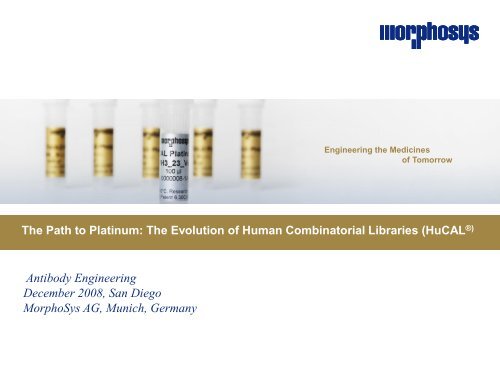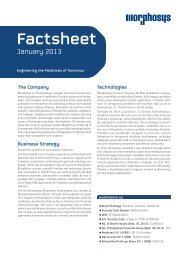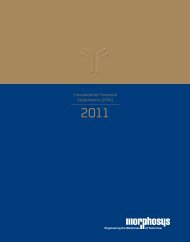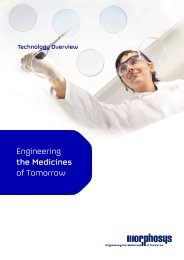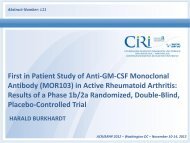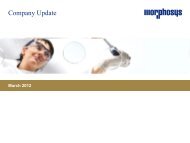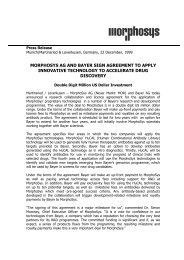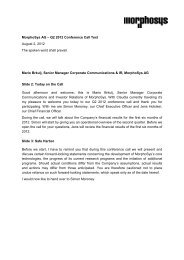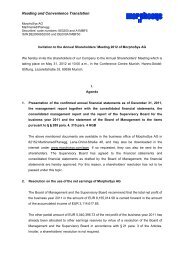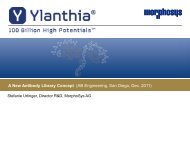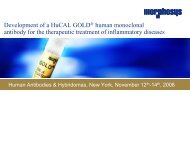You also want an ePaper? Increase the reach of your titles
YUMPU automatically turns print PDFs into web optimized ePapers that Google loves.
Engineering the Medicines<br />
of Tomorrow<br />
The Path to <strong>Platinum</strong>: The Evolution of Human Combinatorial Libraries (<strong>HuCAL</strong> ®)<br />
Antibody Engineering<br />
December 2008, San Diego<br />
<strong>MorphoSys</strong> AG, Munich, Germany<br />
© <strong>MorphoSys</strong> AG
Contents<br />
�<strong>MorphoSys</strong>‘ Technology<br />
� Synthetic antibody genes<br />
� Cys Phage Display<br />
� Trinucleotide Technology<br />
�History: Evolution of <strong>HuCAL</strong> Libraries<br />
�Presenting <strong>HuCAL</strong> <strong>Platinum</strong><br />
December 2008, San Diego<br />
© <strong>MorphoSys</strong> AG<br />
Page 2
<strong>MorphoSys</strong> Technology is Unique<br />
<strong>HuCAL</strong> : Human Combinatorial Antibody Library<br />
December 2008, San Diego<br />
TRIM: Trinucleotide Mutagenesis<br />
-S-S-<br />
CysDisplay ®<br />
© <strong>MorphoSys</strong> AG<br />
Page 3
<strong>HuCAL</strong> is Unique in its Design: Master Genes Cover<br />
the Structural Diversity of Human Antibodies<br />
Structures / Folds<br />
Germline Genes<br />
~ 51 VH Genes<br />
~ 40 Vk Genes<br />
~ 30 Vl Genes<br />
132 Ig Variable<br />
Domain Structures<br />
Bioinformatics<br />
Analysis of human<br />
antibody germline and<br />
rearranged genes<br />
Source: Knappik et al. J Mol Biol 2000, 296: 57ff<br />
December 2008, San Diego<br />
Analysis<br />
Grouping into VH/VL subfamilies<br />
according to sequence<br />
homology<br />
<strong>HuCAL</strong> Master<br />
Frameworks<br />
Gene synthesis<br />
Combination of 7 VH and<br />
7 VL <strong>HuCAL</strong> Master<br />
Genes covers structural<br />
diversity<br />
© <strong>MorphoSys</strong> AG<br />
Page 4
<strong>HuCAL</strong>: Sequence Diversity of Human CDRs<br />
Bioinformatics<br />
Rearranged Sequences<br />
G N G N T K<br />
N S G N T A<br />
G G S N T K<br />
N S G N T A<br />
N S G N T G<br />
N T G G T N<br />
S G V T T K<br />
N S G G T N<br />
Y N G N T N<br />
N S G N T G<br />
Y N G N T N<br />
N S G G T N<br />
Positional Frequency<br />
(Statistic)<br />
CDR Design<br />
60N 50S 80G 70N 100T 50N<br />
15G 25N 10S 20G 25K<br />
15Y 15G 10V 10T 15A<br />
5S 15T 10G<br />
Knappik et al., JMB (2000) 296, 57-86<br />
TRIM Oligo Synthesis Library Construction<br />
<strong>HuCAL</strong> Frameworks<br />
+<br />
CDR Design<br />
Taking care of<br />
structural residues<br />
Using diversity where<br />
it matters<br />
Capturing the natural<br />
repertoire<br />
Minimizing the risk of<br />
immunogenicity<br />
December 2008, San Diego © <strong>MorphoSys</strong> AG<br />
Page 5
<strong>HuCAL</strong> – A Modular Fully Human Library with<br />
Diversified CDRs<br />
Pre-Built Trinucleotide Cassettes<br />
HCDR1<br />
HCDR2<br />
HCDR3 LCDR1 LCDR2 LCDR3<br />
7 x <strong>HuCAL</strong> VH 7 x <strong>HuCAL</strong> VL<br />
� Master genes are close to human germline sequences<br />
- Cover structural diversity in man<br />
� Diverse repertoires in all 6 CDRs<br />
- Diversity designed according to natural distribution in man<br />
- Tailor made using TRIM technology<br />
� Fully modular<br />
- Engineering, optimization<br />
December 2008, San Diego © <strong>MorphoSys</strong> AG<br />
Page 6
<strong>HuCAL</strong>’s Modularity Facilitates Efficient,<br />
Targeted and Controlled Affinity Optimization<br />
Selection of <strong>HuCAL</strong> Fab<br />
with functional activity<br />
Selective and controlled<br />
diversification of CDRs<br />
HCDR2<br />
LCDR1 LCDR3<br />
� CDR optimization without altering framework regions<br />
Optimized drug<br />
candidate<br />
� Highly diverse CDRs designed according to natural distribution<br />
in man<br />
� Optimization of a single Fab as well as a pool of Fabs<br />
� CDRs can be optimized in sequentially or parallel<br />
� Combination of optimized heavy and light chain possible<br />
December 2008, San Diego © <strong>MorphoSys</strong> AG<br />
Page 7
CysDisplay Uniquely Enables Selection of High<br />
Affinity Antibodies<br />
Fab<br />
DTT<br />
V H<br />
Phage<br />
December 2008, San Diego<br />
-SS-<br />
V L<br />
� Display of Fab via disulfide linkage to phage (pIII)<br />
No genetic fusion between Fab and phage protein<br />
Cysteines at N-terminus of pIII as well as C-terminus<br />
of Fab<br />
Disulfide bond formation between Fab and pIII in the<br />
periplasm ensures linkage of phenotype and genotype<br />
� Specific elution of Fabs<br />
Independent of antibody affinity<br />
Especially suited for selection of high affinity<br />
antibodies<br />
Easy and fast procedure, independent of type of<br />
antigen<br />
Applicable for high throughput<br />
© <strong>MorphoSys</strong> AG<br />
Page 8
Trinucleotide Technology<br />
Trinucleotide-directed mutagenesis (TRIM)<br />
[Exclusive license from Johns Hopkins University in Baltimore, MD, U.S.A.]<br />
� Excellent coupling yields 96%-98.5%<br />
� Controlled relative coupling rates of each individual trinucleotide<br />
December 2008, San Diego © <strong>MorphoSys</strong> AG<br />
Page 9
The TRIM Technology Ensures <strong>HuCAL</strong>’s High<br />
Quality and Functionality<br />
TRIM: Trinucleotide Mutagenesis<br />
TRIM uses 20 pre-assembled trinucleotides<br />
in standard DNA synthesis<br />
Codon based TRIM technology provides<br />
solely the desired amino acids<br />
Trp<br />
A<br />
Cys<br />
...CAT TG<br />
ACT... ...HisStopThr... T Tyr<br />
Phe<br />
Leu<br />
TG<br />
Mono:<br />
TRIM:<br />
TGG<br />
...CAT TAT ACT...<br />
TTT<br />
Trp<br />
...His Tyr Thr...<br />
Phe<br />
<strong>HuCAL</strong> CDRs are highly diverse<br />
and human<br />
No stop codons or frameshifts<br />
No undesired or rare codons<br />
Length variation<br />
Ratio (bias) of amino acids in<br />
any subset<br />
Framework specific CDR<br />
subsets<br />
December 2008, San Diego © <strong>MorphoSys</strong> AG<br />
Page 10
TRIM Diversification Strategies<br />
Diversification of amino acid<br />
composition<br />
T 1 T 2 T 3<br />
D 5% 4.4%<br />
E 5% 4.4%<br />
K 5% 4.4%<br />
R 5% 20% 4.4%<br />
H 5% 20% 4.4%<br />
T 5% 4.4%<br />
S 5% 15%<br />
N 5% 4.4%<br />
Q 5% 4.4%<br />
G 5% 15%<br />
A 5% 4.4%<br />
C<br />
P 5% 4.4%<br />
V 5% 4.4%<br />
I 5% 4.4%<br />
L 5% 50% 4.4%<br />
M 5% 4.4%<br />
F 5% 5% 4.4%<br />
Y 5% 15%<br />
W 5% 5% 4.4%<br />
T 1:<br />
Full randomized<br />
T 2:<br />
Biased<br />
T3:<br />
Full randomized but<br />
weighted<br />
T = TRIM Mixture<br />
Diversification of CDR Regions<br />
� Single Position<br />
atg-ggc-T1-ccg-atc<br />
� Multiple Position<br />
(e.g. CDR1/2)<br />
ggc-T1-ccg-T2-T3-ccg-<br />
� Continuous Sequences<br />
(e.g. HCDR-3)<br />
T1-(T2) 4-(T3) 3 -T4 -T5 - T6 -T7 -<br />
December 2008, San Diego © <strong>MorphoSys</strong> AG<br />
Page 11
Limits of Trinucleotide Oligos Synthesis<br />
� High coupling efficiency in trinucleotide<br />
cassette synthesis is mandatory<br />
� Working example: HCDR3 cassette with<br />
15 - 23 TRIM coupling steps<br />
HCDR3 Lenght Trim Positions 15aa 16aa 17aa 18aa 19aa 20aa 21aa 22aa 23aa<br />
No sequences 33 42 20 35 39 36 36 31 32<br />
No seq without mistake 27 32 14 30 26 21 26 19 19<br />
% without mistake 82 76 70 86 67 58 72 61 59<br />
No seq functional (+/-TRIM) 31 37 20 34 36 30 33 29 26<br />
TRIM Insertion 2 4 6 3 9 8 7 7 7<br />
TRIM Deletion 2 1 0 0 1 1 0 3 0<br />
Nucleotide Insertion/Deletion 2 5 0 2 3 5 3 2 6<br />
% functional (+/-TRIM) 94 88 100 97 92 83 92 94 81<br />
Coupling<br />
Efficiency<br />
Synthesis Yield<br />
15 aa 23 aa<br />
95% 46% 30%<br />
90% 20% 9%<br />
85% 8% 2%<br />
80% 3.5% 0.6%<br />
<strong>MorphoSys</strong> commissioned ELLA Biotech for TRIM services<br />
December 2008, San Diego © <strong>MorphoSys</strong> AG<br />
Page 12
Diversity/Composition of TRIM-Mixtures<br />
Kabat Position<br />
97-100 b 100 c-d 100 e-h � Positional amino acid frequency<br />
planned (P) and found (F) can be<br />
precisely adusted even in<br />
complex TRIM mixtures<br />
TRIM Mixture TRIM3 TRIM4 TRIM5<br />
F P F P F P<br />
D 4 5 4 3 1 1<br />
E 1 1 1 3 2 1<br />
K 0,5 1 1 3 1 1<br />
R 5 5 4 3 8 8<br />
H 1 1 1 3 4 1<br />
T 7 5 6 3 2 1<br />
S 18 15 17 10 11 8<br />
N 1 1 1 3 1 1<br />
Q 1 1 2 3 3 1<br />
G 12 15 12 15 7 8<br />
A<br />
C<br />
5 5 5 3 2 1<br />
P 7 5 6 3 11 8<br />
V 8 5 7 3 3 1<br />
I 5 5 5 3 2 1<br />
L 6 5 5 3 2 1<br />
M 0,5 1 1 3 2 1<br />
F 1 1 2 3 3 1<br />
Y 16 15 18 20 31 30<br />
W 2 1 2 3 3 1<br />
Occupation 19 19 19 19 19 19<br />
No Seq 3640 1213 1565<br />
December 2008, San Diego © <strong>MorphoSys</strong> AG<br />
Page 13
<strong>HuCAL</strong> Libraries – The Path to <strong>Platinum</strong><br />
� <strong>HuCAL</strong>-scFv 1<br />
� <strong>HuCAL</strong>-scFv 2<br />
� <strong>HuCAL</strong>-scFv 3<br />
December 2008, San Diego<br />
� <strong>HuCAL</strong>-Fab 1<br />
� <strong>HuCAL</strong>-Fab 2<br />
� <strong>HuCAL</strong> GOLD<br />
� <strong>HuCAL</strong> <strong>Platinum</strong><br />
© <strong>MorphoSys</strong> AG<br />
Page 14
History of <strong>HuCAL</strong> Libraries<br />
Antibody<br />
Format<br />
Phage Display<br />
system<br />
Major steps in <strong>HuCAL</strong> Technology<br />
� Fab antibody format<br />
� CysDisplay<br />
� Increase diversity in CDR-1 and CDR-2<br />
Diversified<br />
CDR regions<br />
scFv-1 scFv genetic fusion 2<br />
scFv-3 scFv cys display 2<br />
Fab-1 Fab genetic fusion 2<br />
<strong>HuCAL</strong> Gold Fab cys display 6<br />
<strong>HuCAL</strong> <strong>Platinum</strong> Fab cys display 6<br />
December 2008, San Diego © <strong>MorphoSys</strong> AG<br />
Page 15
<strong>HuCAL</strong> <strong>Platinum</strong> – Making GOLD Brighter<br />
<strong>HuCAL</strong> <strong>Platinum</strong> Concept<br />
Key Features:<br />
� Increase functional HCDR3 by length-dependent<br />
design of HCDR3<br />
� Optimized selection of frameworks<br />
� Minimized numbers of non-germline positions<br />
� Gene optimization of master genes<br />
� Massively reduced number of potential<br />
glycosylation sites<br />
� Three times the size of <strong>HuCAL</strong> GOLD<br />
December 2008, San Diego © <strong>MorphoSys</strong> AG<br />
Page 16
A New HCDR3 Design to Cover<br />
Human Structure and Functional Diversity<br />
FREQUENCY %<br />
20,0<br />
15,0<br />
10,0<br />
5,0<br />
0,0<br />
4 6 8 10 12 14 16 18 20 22<br />
Zemlin et al. , JMB_2003_334(4)_733-479<br />
Loop lenght<br />
Nature GOLD Design GOLD Found<br />
December 2008, San Diego © <strong>MorphoSys</strong> AG<br />
Page 17<br />
Zemlin et al. , JMB_2003_334(4)_733-479<br />
� Zemlin et al. showed a length dependent<br />
aa composition of HCDR3<br />
� Increase in long CDR: Y, S, P, K and C<br />
� Decrease in long CDR: G, R
HCDR3 Design<br />
1. Separate analysis of HCDR3 length 4-23aa (in total 8,900 sequences)<br />
2. Alignment of all lengths according to aa content of HCDR3<br />
… 97 98 99 100a 100b 100c … 100m 100n 100o 101 102<br />
13aa 15% G 15% G 16% G 19% G 16% G 13% G 14% G 15% G 65% F 88% D 40% Y<br />
10% S 12% S 16% S 15% S 13% S 11% S 6% S 4% S 13% M 17% I<br />
9% Y 11% Y 10% Y 11% Y 11% Y 17% Y 24% Y 26% Y 15% V<br />
14aa 16% G 14% G 17% G 17% G 16% G 13% G 13% G 14% G 18% G 58% F 87% D 37% Y<br />
11% S 13% S 15% S 15% S 15% S 12% S 10% S 6% S 3% S 17% M 20% V<br />
7% Y 9% Y 13% Y 7% Y 12% Y 17% Y 22% Y 27% Y 24% Y 16% I<br />
15aa 18% G 11% G 14% G 17% G 18% G 16% G 14% G 11% G 13% G 21% G 60% F 92% D 33% Y<br />
9% S 12% S 13% S 17% S 16% S 17% S 11% S 9% S 7% S 4% S 21% M 24% V<br />
13% Y 14% Y 11% Y 10% Y 9% Y 16% Y 23% Y 26% Y 30% Y 23% Y 14% I<br />
16aa 16% G 14% G 14% G 13% G 15% G 18% G 14% G 9% G 7% G 11% G 26% G 52% F 92% D 37% V<br />
8% S 12% S 15% S 18% S 18% S 17% S 8% S 8% S 12% S 4% S 1% S 31% M 26% Y<br />
12% Y 14% Y 9% Y 10% Y 9% Y 11% Y 26% Y 33% Y 33% Y 37% Y 25% Y 12% I<br />
Increasing Y-content<br />
Conserved<br />
C-terminus<br />
December 2008, San Diego © <strong>MorphoSys</strong> AG<br />
Page 18
HCDR3 Design in <strong>HuCAL</strong><br />
<strong>HuCAL</strong> Gold Design<br />
HCDR3 Lenght aa<br />
Kabat 95 96 97 98 99 100 a b c d e f g h i j k l m n 101 102<br />
AHO 109 110 111 112 113 114 115 116 117 118 119 120 121 122 123 124 125 126 128 129 130 131<br />
15 W<br />
16 W<br />
17 W<br />
18 FW3 W<br />
19 W<br />
20 W<br />
21 W<br />
22 W<br />
<strong>HuCAL</strong> <strong>Platinum</strong> Design<br />
HCDR3 Lenght aa<br />
Kabat 95 96 97 98 99 100 a b c d e f g h i j k l l' m n 101 102<br />
AHO 109 110 111 112 113 114 115 116 117 118 119 120 121 122 123 124 125 126 127 128 129 130 131<br />
15 W<br />
16 W<br />
1.5 % Y<br />
15 % Y<br />
15 % Y<br />
20 % Y<br />
30 % Y<br />
17 W<br />
18 W<br />
19 FW3 W<br />
20 W<br />
21 W<br />
22 W<br />
23 W<br />
� HCDR3 design in <strong>HuCAL</strong> <strong>Platinum</strong> reflects the length-dependent<br />
aa composition found in nature<br />
December 2008, San Diego © <strong>MorphoSys</strong> AG<br />
Page 19<br />
45 % Y<br />
55 % Y<br />
FW4<br />
FW4
<strong>HuCAL</strong> <strong>Platinum</strong>:<br />
HCDR3 Length Distribution<br />
Frequency %<br />
Design and composition of Library HCDR3 selected from Library<br />
14,0<br />
12,0<br />
10,0<br />
8,0<br />
6,0<br />
4,0<br />
2,0<br />
0,0<br />
Lenght Distribution HCDR3<br />
4 5 6 7 8 9 10 11 12 13 14 15 16 17 18 19 20 21 22 23<br />
� Composition Library = Design<br />
aa<br />
Planned<br />
Library<br />
� Increased number of long HCDR3<br />
December 2008, San Diego © <strong>MorphoSys</strong> AG<br />
Page 20<br />
Unique binder<br />
50<br />
45<br />
40<br />
35<br />
30<br />
25<br />
20<br />
15<br />
10<br />
5<br />
0<br />
4 5 6 7 8 9 10 11 12 13 14 15 16 17 18 19 20 21 22 23<br />
HCDR3 length (aa)<br />
<strong>HuCAL</strong> Gold (N=100)<br />
<strong>HuCAL</strong> <strong>Platinum</strong> (N=300)<br />
<strong>HuCAL</strong> <strong>Platinum</strong> delivers higher number of sequences with long HCDR3
Controlled Diversity to Avoid<br />
……Undesired Motifs<br />
HCDR2<br />
Nat. Seq Gold<br />
<strong>Platinum</strong><br />
Kabat 50 51 52 50 51 52 50 51 52<br />
25% V 90% I 63% S 20% V I 66% S 24% V I 66% S<br />
15% A … …. 12% A …. 14% A ….<br />
11% S … …. 12% S …. 14% S ….<br />
11% Y …. 12%Y …. 14% Y ….<br />
10% N 12% N<br />
9 % G 12% G 14% G<br />
…. …. ….<br />
…. …. ….<br />
…. …. ….<br />
N x S/T 6,3% 7,9% 0%<br />
� Potential N-glycosylation site can be avoided by omitting either N or S/T in<br />
TRIM Mixtures of known hot spots<br />
December 2008, San Diego © <strong>MorphoSys</strong> AG<br />
Page 21
Reduced Number of<br />
Potential Glycosylation Sites<br />
� Hot spots of NxS/T site found in Gold were removed or at least<br />
dramatically reduced in <strong>Platinum</strong><br />
� NxS/T could not be eleminated completely without losing<br />
significant sequence diversity<br />
% Glycosylation sites<br />
2.0<br />
1.5<br />
1.0<br />
0.5<br />
0.0<br />
Potential Glycosylation sites: Gold (30%) vs. <strong>Platinum</strong> (5%)<br />
December 2008, San Diego<br />
LCDR1 LCDR2 LCDR3 HCDR1 HCDR2 HCDR3<br />
Library<br />
<strong>Platinum</strong><br />
Number of<br />
clones<br />
analysed<br />
© <strong>MorphoSys</strong> AG<br />
Glycosylation<br />
sites<br />
Lambda<br />
VH1A 83 4.8%<br />
VH1B 89 2.2%<br />
VH2 87 5.7%<br />
VH3-23 142 4.9%<br />
VH3-15 80 3.7%<br />
VH5 67 4.8%<br />
VH6 88 3.4%<br />
kappa<br />
VH1A 85 3.5%<br />
VH1B 106 5.4%<br />
VH2 78 5%<br />
VH3-23 141 5.7%<br />
VH3-15 85 3.5%<br />
VH5 94 5%<br />
VH6 86 6%<br />
1311 5%<br />
Page 22
<strong>HuCAL</strong> <strong>Platinum</strong>:<br />
Size and Correctness<br />
<strong>Platinum</strong> Library<br />
Library size<br />
Gold<br />
-Libraries<br />
Library size<br />
<strong>Platinum</strong><br />
Number of<br />
correct clones,<br />
Sequencing (95<br />
clones) [%]<br />
pM30_VL1-3_VH1A<br />
3,8E+09 72%<br />
6,1E+08<br />
pM30_VL1-3_VH1B 1,4E+09 76.4%<br />
pM30_VL1-3_VH2 5,4E+08 7,7E+08 74.7%<br />
pM30_VL1-3_VH3-23 3,4E+09 3,7E+09 70,4%<br />
pM30_VL1-3_VH3-15 - 5,2E+09 64%<br />
pM30_VL1-3_VH5 6,9E+08 4,3E+09 70%<br />
pM30_VL1-3_VH6 1,7E+09 3,8E+09 72%<br />
-Libraries<br />
pM30_Vk1-3_VH1A<br />
5,1E+09 83%<br />
5,0E+08<br />
pM30_Vk1-3_VH1B 9,0E+08 76%<br />
pM30_Vk1-3_VH2 2,9E+09 1,2E+09 79%<br />
pM30_Vk1-3_VH3-23 3,3E+09 1,7E+09 72%<br />
pM30_Vk1-3_VH3-23 II 3,3E+09 5,0E+09 75%<br />
pM30_Vk1-3_VH3-15 - 4,6E+09 76%<br />
pM30_Vk1-3_VH5 1,2E+09 2,0E+09 73%<br />
pM30_Vk1-3_VH6 7,7E+08 1,8E+09 65%<br />
Combined Library 1,6E+10 4,5E+10 74%<br />
* More rigid criteria were applied for <strong>Platinum</strong> vs. GOLD e.g. missing TRIMs were counted as errors<br />
• <strong>HuCAL</strong> <strong>Platinum</strong> is<br />
around three times as<br />
large as <strong>HuCAL</strong> GOLD<br />
• <strong>HuCAL</strong> GOLD contains<br />
64% correct clones,<br />
<strong>Platinum</strong> even 74%*<br />
December 2008, San Diego © <strong>MorphoSys</strong> AG<br />
Page 23
<strong>HuCAL</strong> <strong>Platinum</strong>: Test Selections<br />
Antigen Type<br />
Primary Hit<br />
rate<br />
<strong>Platinum</strong><br />
> 5 x bgd<br />
Primary Hit<br />
rate GOLD<br />
> 5 x bgd<br />
<strong>Platinum</strong> GOLD<br />
gfp soluble 352 75 54 8<br />
CD20 AgX 36 10 12 4<br />
CD25 Fc Fusion 702 526 105 20<br />
TrailR2 Fc Fusion 651 468 72 19<br />
MOR103 anti Id 251 346 18 8<br />
MOR202 anti Id 646 662 39 25<br />
Sum 300 84<br />
Unique Sequences<br />
120<br />
100<br />
80<br />
60<br />
40<br />
20<br />
0<br />
soluble AgX Fc Fusion Fc Fusion anti Id anti Id<br />
gfp CD20 CD25 TrailR2 MOR103 MOR202<br />
<strong>HuCAL</strong> <strong>Platinum</strong> shows 3.6 fold increased hit diversity<br />
compared to <strong>HuCAL</strong> GOLD<br />
December 2008, San Diego © <strong>MorphoSys</strong> AG<br />
Page 24<br />
<strong>Platinum</strong><br />
GOLD
Library Sequence Optimization<br />
� <strong>HuCAL</strong> Master genes optimized in collaboration with<br />
GENEART AG<br />
� Optimized codons for E.coli expression and eukaryotic<br />
expression system<br />
� mRNA secondary structures removed<br />
� Negative regulatory sequence motifs in prokaryotic and<br />
eukaryotic system were avoided<br />
December 2008, San Diego © <strong>MorphoSys</strong> AG<br />
Page 25
<strong>HuCAL</strong> <strong>Platinum</strong>:<br />
Optimized on DNA Level<br />
Genes optimized by GeneOptimizer® Software<br />
(no aa changes introduced)<br />
Prokaryotic<br />
inibitory<br />
motif<br />
Removed problematic sites<br />
Consensus<br />
splice site<br />
Cryptic<br />
splice site<br />
RNA<br />
instability<br />
motif<br />
VH1A 1<br />
VH1B 1 1<br />
VH2 1<br />
VH3-23 1<br />
VH3-15 1<br />
VH5 1 1<br />
VH6 1<br />
Vl-1 1<br />
Vl-2 1 1<br />
Vl-3 1<br />
Vk-1 1 2<br />
Vk-2 2<br />
Vk-3 2<br />
Alternative<br />
start codon<br />
CH1 1 3<br />
CL-k 1 1<br />
CL-l 1<br />
Codon usage optimized<br />
for E. coli<br />
Rare mammalian<br />
codons avoided<br />
Number of potential problematic DNA sites significantly reduced<br />
December 2008, San Diego © <strong>MorphoSys</strong> AG<br />
Page 26
Expression Rates <strong>Platinum</strong><br />
mg/L<br />
mg/l culture<br />
40<br />
30<br />
20<br />
10<br />
0<br />
VH1A<br />
Fab Fab Expression mg/L<br />
after after purification [mg/L]<br />
VH1B<br />
VH2<br />
VH3_15<br />
VH3_23<br />
VH5<br />
VH6<br />
Fab Expression levels from four different projects<br />
Average 14.2mg/l (n=104)<br />
IgG1 IgG Expression Expression mg/L<br />
after after purification [mg/L]<br />
IgG1f pMorph4 Expression levels from four different projects<br />
Average 28.1mg/l (n=38); <strong>HuCAL</strong> Gold 14mg/l<br />
<strong>HuCAL</strong> <strong>Platinum</strong> shows twice the expression rate on IgG level compared to GOLD<br />
December 2008, San Diego © <strong>MorphoSys</strong> AG<br />
Page 27<br />
mg/l culture<br />
mg/L<br />
80<br />
60<br />
40<br />
20<br />
0<br />
GFP<br />
TrailR2<br />
CD25<br />
AgX
<strong>HuCAL</strong> <strong>Platinum</strong> Delivers Extraordinarily<br />
High Affinities: Parental vs. RapMat<br />
Affinity [pM]<br />
KD in [pM] SET<br />
Best affinities naïve library: 22pM<br />
Best affinities RapMAT: 12pM<br />
Preselected by affinity screen<br />
<strong>Platinum</strong> delivers extraordinarily high affinities from the naïve<br />
library which can be quickly improved further by RapMAT<br />
December 2008, San Diego © <strong>MorphoSys</strong> AG<br />
Page 28
<strong>HuCAL</strong> <strong>Platinum</strong><br />
� TRIM Technology applied to generate a high<br />
quality library with over 74% correct clones<br />
� Library size: 4.5 x 10 10<br />
� HCDR3 length distribution mimicking nature<br />
� Low number potential glycosylation sites: 5%<br />
� 3.6-fold higher diversity vs. GOLD on average<br />
� Improved expression rate on IgG and Fab level<br />
December 2008, San Diego © <strong>MorphoSys</strong> AG<br />
Page 29
Thank You.<br />
www.morphosys.com<br />
<strong>HuCAL</strong> ® , <strong>HuCAL</strong> GOLD ® , <strong>HuCAL</strong> PLATINUM ® , CysDisplay ® , RapMAT ® and AutoCAL ® are registered trademarks of <strong>MorphoSys</strong> AG.<br />
Engineering the Medicines<br />
of Tomorrow<br />
© <strong>MorphoSys</strong> AG


